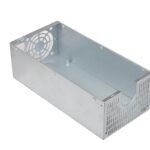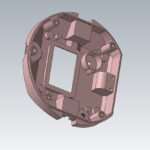CNC machining is a simple tool with untapped potential. But you need other devices and techniques to get the most out of the machining process. On-machine inspection devices are one of the few crucial elements of modern manufacturing that can elevate your machining practices. These devices are integrated into a CNC machine and help maintain dimensional accuracy and precision.
In this article, we give you a crash course in on-machine inspection and the improvements it brings to the machining process.
What is On-Machine Inspection?
On-machine inspection is the process of measuring workpiece dimensions using a device attached to the CNC machine. This system allows machinists to measure the accuracy of the part as it is being machined. On-machine inspection is a replacement for the older CMM (coordinate measuring machine) inspection system.
The most common type of on-machine inspection device comes in the form of a touch probe. Here the touch probe replaces the cutting tool and measures the workpiece on contact. There is a small ball on the tip of the probe shaft (also called a stylus). When this ball touches a surface it gives feedback to the CNC controller.
An alternative to the touch probe is a laser pointer system, which uses the refraction of lasers to measure the dimensions of the workpiece. Laser pointers are faster at taking measurements than touch probes. But they come at the cost of potential optical errors.
What does CMM mean?

CMM (coordinate measuring machine) is an inspection device that measures the dimensions of a machined part. You place the final part on the CMM bed and let the measuring probe take accurate dimensions in six degrees of freedom. The measuring probe can be a mechanical touch-sensitive one or an optical one that uses a laser or white light.
Traditionally you would measure the dimensions by hand using a reference scale or tool. But CMM allows you to take digital measurements using smart sensors and computer software.
Why is On-Machine Inspection Better than CMM?
CMM allows you to measure the final part after it has been machined. While on-machine inspection allows you to measure the part while it is being machined. Once a part has been incorrectly machined, it is very difficult to rework it into a usable form. Even if you can re-machine the part, it will come at the cost of time and disruption to the production cycle.
On-machine inspection will almost immediately measure dimensional errors during machining, allowing the operator to make appropriate corrections.
07 Benefits of On-Machine Inspection

There are several benefits to using on-machine inspection. Whether you’re replacing an existing CMM setup or trying out digital measuring for the first time. On-machine inspection will provide significant improvements to the machining process.
1 – Removing CMM Bottleneck
As mentioned above, CMM is a post-machining measure system. A typical production line involved part machining, then CMM inspection, and finally re-machine if needed. Each step here adds more time to the overall production period. Hence, CMM inspection becomes a major bottleneck to the manufacturing process.
A bottleneck refers to the part of the machining process that has reduced capacity. If all other sectors are producing parts at 100% capacity but the inspection is unable to keep up with the capacity, it will create a bottleneck.
On-machine inspection removes the clunkiness of CMM with a single one-step solution. It combines the inspection and machining phases together and avoids potential bottlenecks.
2 – Improving Production Times
An important aspect of manufacturing is production efficiency. Increased production efficiency will result in faster lead times and an increase in the overall production rate. A standard production line can be held up by a few factors. Machining errors, part inspection, and re-machining all increase production times. And increased production times will result in fewer parts manufactured in a single day.
By adding on-machine inspection to your CNC machines, you remove a majority of the machining errors and quickly perform part inspections. This results in a sharp decrease in the need to rework or re-machine parts. If all your parts are accurately machined in the first place then there will be no need for re-machining.
3 – Better Quality Control
Quality control is a key factor that contributes to a successful business. Maintaining good and consistent product quality across your factory is a tough and expensive endeavor. Parts need to be inspected regularly to ensure that they meet a high standard of quality.
On-machine inspection will inspect the product dimensions as they are being machined. As all the parts are being inspected by a high-quality probe the quality control will be much higher than a manual eye inspection.
4 – Increasing Mold Making Accuracy
Molds are high-priority parts that require the utmost care during machining. Even minor errors and scratches can completely ruin a mold. As the mold will be used to make several thousand parts in its lifetime, accuracy should not be neglected.
On-machine inspection probes are particularly useful here as they can easily measure the internal cavities of a mold. High-performance injection molds are made from high carbon steel which requires low cutting speeds and expensive cutting tools. A mistake here will result in a huge waste of time and a complete scraping of the mold.

5 – Improving Post-Processing Accuracy
Die-cast and forged parts always need some type of post-process machining. These manufacturing processes will produce minor variations between parts. Post-processing removes casting marks, improves surface finish, and makes dimensions more accurate.
Post-process machining is a crucial step that can make or break the final part. Accuracy must be maintained during the process to avoid failures. On-machine inspection allows the operator to maintain accuracy, through quick calibration and near-instant dimension inspection.
6 – Faster Recalibration of Cutting Tool
CNC machining produces accurate and precise parts, with very little room for error. But even the most sophisticated CNC machines will drift over time and will require recalibration. Recalibration is a standard procedure for heavy machinery and is also a time-consuming one. On-machine probing has two major benefits.
a.It allows the operator to catch calibration issues earlier,
b.It helps expedite the recalibration process.
7 – Significantly Reducing Failure Rate
If you take all the above-mentioned benefits and apply them to a machining process, you will notice a drastic reduction in failure rates. An on-machine inspection device doesn’t directly affect the defect or failure of parts, but it reduces the chances of those failures.
Choose QBH Technology for Machining Services
QBH is an expert in manufacturing custom metal parts. We offer several OEM and ODM services in CNC machining, sheet metal fabrication, and metal stamping. Our excellent quality control and on-site inspection system yield exceptionally high-quality parts. We also provide a full dimensional inspection report before product delivery.
Don’t miss out on your best-in-class service and Contact us Now!




